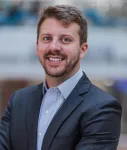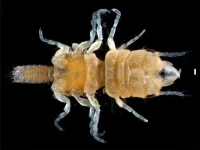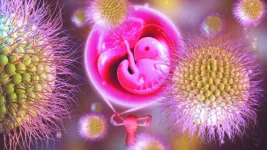(Press-News.org) In-cell engineering can be a powerful tool for synthesizing functional protein crystals with promising catalytic properties, show researchers at Tokyo Tech. Using genetically modified bacteria as an environmentally friendly synthesis platform, the researchers produced hybrid solid catalysts for artificial photosynthesis. These catalysts exhibit high activity, stability, and durability, highlighting the potential of the proposed innovative approach.
Protein crystals, like regular crystals, are well-ordered molecular structures with diverse properties and a huge potential for customization. They can assemble naturally from materials found within cells, which not only greatly reduces the synthesis costs but also lessens their environmental impact.
Although protein crystals are promising as catalysts because they can host various functional molecules, current techniques only enable the attachment of small molecules and simple proteins. Thus, it is imperative to find ways to produce protein crystals bearing both natural enzymes and synthetic functional molecules to tap their full potential for enzyme immobilization.
Against this backdrop, a team of researchers from Tokyo Institute of Technology (Tokyo Tech) led by Professor Takafumi Ueno has developed an innovative strategy to produce hybrid solid catalysts based on protein crystals. As explained in their paper published in Nano Letters on 12 July 2023, their approach combines in-cell engineering and a simple in vitro process to produce catalysts for artificial photosynthesis.
The building block of the hybrid catalyst is a protein monomer derived from a virus that infects the Bombyx mori silkworm. The researchers introduced the gene that codes for this protein into Escherichia coli bacteria, where the produced monomers formed trimers that, in turn, spontaneously assembled into stable polyhedra crystals (PhCs) by binding to each other through their N-terminal α-helix (H1). Additionally, the researchers introduced a modified version of the formate dehydrogenase (FDH) gene from a species of yeast into the E. coli genome. This gene caused the bacteria to produce FDH enzymes with H1 terminals, leading to the formation of hybrid H1-FDH@PhC crystals within the cells.
The team extracted the hybrid crystals out of the E. coli bacteria through sonication and gradient centrifugation, and soaked them in a solution containing an artificial photosensitizer called eosin Y (EY). As a result, the protein monomers, which had been genetically modified such that their central channel could host an eosin Y molecule, facilitated the stable binding of EY to the hybrid crystal in large quantities.
Through this ingenious process, the team managed to produce highly active, recyclable, and thermally stable EY·H1-FDH@PhC catalysts that can convert carbon dioxide (CO2) into formate (HCOO−) upon exposure to light, mimicking photosynthesis. In addition, they maintained 94.4% of their catalytic activity after immobilization compared to that of the free enzyme. “The conversion efficiency of the proposed hybrid crystal was an order of magnitude higher than that of previously reported compounds for enzymatic artificial photosynthesis based on FDH,” highlights Prof. Ueno. “Moreover, the hybrid PhC remained in the solid protein assembly state after enduring both in vivo and in vitro engineering processes, demonstrating the remarkable crystallizing capacity and strong plasticity of PhCs as encapsulating scaffolds.”
Overall, this study showcases the potential of bioengineering in facilitating the synthesis of complex functional materials. “The combination of in vivo and in vitro techniques for the encapsulation of protein crystals will likely provide an effective and environmentally friendly strategy for research in the areas of nanomaterials and artificial photosynthesis,” concludes Prof. Ueno.
And we sure hope that these efforts will lead us to a greener future!
###
Ueno Lab.
About Tokyo Institute of Technology
Tokyo Tech stands at the forefront of research and higher education as the leading university for science and technology in Japan. Tokyo Tech researchers excel in fields ranging from materials science to biology, computer science, and physics. Founded in 1881, Tokyo Tech hosts over 10,000 undergraduate and graduate students per year, who develop into scientific leaders and some of the most sought-after engineers in industry. Embodying the Japanese philosophy of “monotsukuri,” meaning “technical ingenuity and innovation,” the Tokyo Tech community strives to contribute to society through high-impact research.
https://www.titech.ac.jp/english/
END
Can poor sleep and circadian rhythm make chronic pain conditions worse? Edson College Assistant Professor Chung Jung Mun plans to find out through an innovative longitudinal study.
Mun was awarded a $3 million grant from the National Institute of Neurological Disorders and Stroke, part of the U.S. National Institutes of Health, to explore the possible connection.
“There are countless individuals suffering from multiple chronic pain disorders. A person with chronic migraine headaches is also likely to suffer from chronic low back pain. What we’re trying to find ...
A Texas A&M University doctoral student has collaborated with an innovative surgical navigation and robotics company on motion capture research that can potentially improve implant alignment during knee replacement surgeries.
Aaron Henry is a fourth-year Ph.D. student in the Doctor of Philosophy in Interdisciplinary Engineering program in the Department of Multidisciplinary Engineering. He worked with Caira Surgical, a surgical navigation and robotic orthopedic surgery company that focuses on simplifying workflows and developing technological ...
A mouse injured on one leg experiences an “awakening” of stem cells in the other leg as if the cells are preparing to heal an injury. Something similar happens in axolotls, which are masters at limb regeneration. Heart injuries in zebrafish can trigger certain changes in far-away organs like the kidney and brain.
“In many different organisms, you can see the whole body respond to an injury. But whether or not those responses actually have any function has been unclear,” says Bo Wang, assistant professor of bioengineering at Stanford, “So that’s what we’re focusing on.”
In ...
Jakarta … San Francisco … Shanghai … Phoenix … Houston.
These major cities and others around the globe have many similarities, but they share one particular commonality that is concerning for residents. They are among the global cities most affected by climate change.
While each of these cities has proven resilient for centuries, urban planners, community leaders and civil engineers continue to address their many environmental challenges. In preparing for these cities’ future, however, it might be more ...
Most of the earthquakes rumbling under the West’s Great Basin come in surges, clustered together in time and place. Scientists call these seismic groups “swarms,” which are a distinct category from the numerous aftershocks following a big shake, such as the 5.7 magnitude Magna quake of 2020 on the Wasatch Fault.
Rather than getting spread out evenly over time, many of these small, often imperceptible quakes strike a region in a short period of time, say a few days or weeks.
Central Utah has been the stage for dozens of earthquake swarms that have been recorded over the past 40 years by an ever-expanding network of seismic arrays managed by the University ...
Encouraging Latinx adolescents of Mexican origin to embrace their ethnic pride, cultural values, and connections to their cultural community contributes to positive development and better adjustment during adolescence, a new University of California, Davis, psychology study suggests.
Moreover, researchers said, cultural preservation can help Latinx youth cope with adverse life experiences and social threats such as racism and discrimination.
The study results were published this month in ...
A Chapman University scientist and his colleagues have determined how the Earth responds as it heats up due to climate change.
The scientists say a warming world calls for a new approach in detecting how much carbon dioxide comes out of ecosystems when the temperature changes — which tells us how well plants and soil can alleviate damage by removing carbon pollution from the atmosphere. The study is the first to find the temperature-carbon dioxide release relationship at the landscape level.
Their ...
An international team of scientists from the University of Miami Rosenstiel School of Marine, Atmospheric, and Earth Science and the Water Research Group from the Unit for Environmental Sciences and Management at the North-West University in South Africa have discovered a new species of marine cryptofauna in the Florida Keys. Cryptofauna are the tiny, hidden, organisms that make up the majority of biodiversity in the ocean.
The roughly three-millimeter-long isopod is one of only 15 species from the genus Gnathia currently known in the region.
The newly discovered species, Gnathia jimmybuffetti, which is a member of a group of crustaceans called gnathiid isopods, were collected ...
PORTLAND, Ore. – Researchers in the Oregon State University College of Pharmacy have developed a drug delivery system that shows promise for greatly enhancing the efficacy of the medicine given to women with the life-threatening condition of ectopic pregnancy, which occurs when a fertilized egg implants somewhere other than the lining of the uterus.
Olena Taratula of the OSU College of Pharmacy, and Maureen Baldwin and Leslie Myatt of Oregon Health & Science University led a team that used a mouse model to show ...
At first glance, Canada appears to have responded adequately to the covid-19 emergency, but beneath the surface lie major pandemic failures, warns a series of articles published by The BMJ today.
The BMJ Canada Covid Series provides a critical analysis of what worked and what didn’t in Canada’s covid-19 response and calls for a national independent review to learn lessons and ensure accountability for the past and future preparedness.
The articles, written by leading clinicians and researchers representing 13 institutions across Canada, highlight long-standing weaknesses ...




